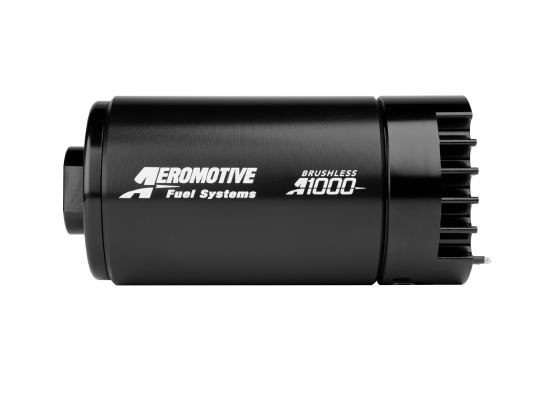Understanding port threads, adapter fittings, and line sizes.
The designation “AN” stands for Army/Navy and calls out military specifications (mil/spec) for dimensional standards of hydraulic lines, hose-end connectors, and port adapter fittings. AN specifications are a popular standard met by all companies that manufacture AN-style performance fuel hose and accessories. For many, there has been a lot of confusion about the subject of AN lines, NPT and ORB ports, and how all of this works together.
The flare angle used to seal AN connections is required to be SAE 37-degree, as opposed to the 45-degree flare commonly found on household plumbing adapters. This angle can be found on the male point of the port adapter fitting and on the female inside the hose-end nut. AN port threads are not NPT or “pipe thread.” Instead, they use straight threads (like any normal fastener) and an SAE O-Ring Boss (ORB) for sealing. AN lines, ORB ports, and the appropriate port adapter fittings are measured in inch/fractional sizes.
AN line sizes will have a dash (-) preceding the line size. The number after the dash refers to the number of sixteenths of an inch the line size is. For example, take a –08 AN line. Put the eight over sixteen and you get 8/16”, which reduces down to ½”.
Common army/navy (AN) line and thread specifications
-04 AN line = 4/16” = 1/4” hard line. –04 AN Port and Fitting thread is: 7/16” -20 TPI.
-06 AN line = 6/16” = 3/8” hard line. –06 AN Port and Fitting thread is: 9/16” -18 TPI.
-08 AN line = 8/16” = 1/2” hard line. –08 AN Port and Fitting thread is: 3/4” -16 TPI.
-10 AN line = 10/16” = 5/8” hard line. –10 AN Port and Fitting thread is: 7/8” -14 TPI.
-12 AN line = 12/16” = 3/4” hard line. –12 AN Port and Fitting thread is: 1-1/16”-12 TPI.
Modern, high performance fuel systems are predominately fitted with safer, better sealing, higher flowing, AN-ORB ports. These ports require a straight thread adapter fitting, with a sealing O-Ring installed over the threads, up to the hex, that disappears into the port when properly installed. No additional thread sealer is required or recommended.
National Pipe Thread (NPT) ports, AN Ports and port adapter fittings
Over the years, in low-pressure hydraulics, NPT has been a popular thread for ports and adapter fittings. When NPT ports are used in a fuel system with AN line, an adapter fitting to convert from NPT to AN is required. NPT was designed for use with thick walled pipe, typically black pipe, used in fixed structures like buildings, to handle distribution of water and natural gas. Black pipe isn’t particularly bendable, flexible, or lightweight, and is hardly desirable for plumbing a high-performance fuel system. As a result, fittings that adapt NPT ports to AN line are common to allow flexible AN lines to be utilized in performance automotive fuel systems.
Unlike AN thread, which is straight, NPT ports and fittings are tapered. NPT male-to-female adapters start loose, threading easily, but get tight and harder to turn well before the hex touches the port. When threaded together, the NPT design creates a wedging effect, binding the thread in order to seal. The use of a thread sealant is common and required with NPT, as it does not consistently create a positive seal on it’s own. It’s common to see a number of threads showing on the adapter fitting when NPT is sufficiently tight, making NPT assemblies bulkier and less clean appearing than a similar AN assembly.
NPT ports are commonly adapted to AN lines, but the NPT size designation is confusing because NPT ports identify the pipe I.D. rather than the O.D. Black pipe has a much thicker wall than hard line, so the pipe/port O.D. is much larger than the NPT size would seem to indicate. For example, a 3/8” NPT port will have an outside diameter of 5/8,” allowing for a wall thickness of 1/8” (0.125”). As a result, NPT port sizes allow use of a one-step larger AN line than their indicated size would seem to support. As long as the wall of the adapter fitting is not overly thick, the following NPT-to-AN adapters will provide a common I.D. through-hole:
Maximum AN line for NPT port size
1/4” NPT is compatible with up to -6 AN (3/8” hard line)
3/8” NPT is compatible with up to –8 AN (1/2” hard line)
1/2” NPT is compatible with up to –10 AN (5/8” hard line)
3/4” NPT is compatible with up to -16 AN (1” hard line)
Adapter fittings are available for connecting larger than recommended AN lines to the above NPT ports. Beware, the inside diameter of the adapter fitting will be smaller on the NPT side, creating a flow restriction that many racers and hotrod enthusiasts overlook. This is a poor practice and should be avoided, but when no alternative is available, consider sourcing a steel NPT to AN adapter from a good hydraulic supplier. Steel adapters will have a thinner wall than aluminum, due to the increase in material strength, leaving a larger I.D. to support higher flow on the too-small NPT side of the adapter.













